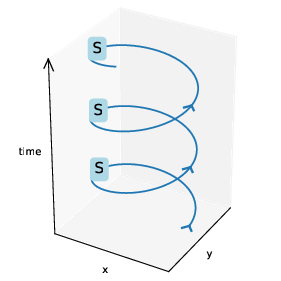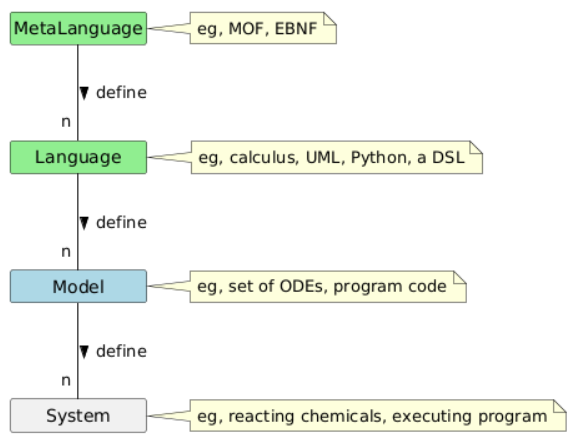Open Questions about Time and Self-reference in Living Systems (2508.11423v1)
Abstract: Living systems exhibit a range of fundamental characteristics: they are active, self-referential, self-modifying systems. This paper explores how these characteristics create challenges for conventional scientific approaches and why they require new theoretical and formal frameworks. We introduce a distinction between 'natural time', the continuing present of physical processes, and 'representational time', with its framework of past, present and future that emerges with life itself. Representational time enables memory, learning and prediction, functions of living systems essential for their survival. Through examples from evolution, embryogenesis and metamorphosis we show how living systems navigate the apparent contradictions arising from self-reference as natural time unwinds self-referential loops into developmental spirals. Conventional mathematical and computational formalisms struggle to model self-referential and self-modifying systems without running into paradox. We identify promising new directions for modelling self-referential systems, including domain theory, co-algebra, genetic programming, and self-modifying algorithms. There are broad implications for biology, cognitive science and social sciences, because self-reference and self-modification are not problems to be avoided but core features of living systems that must be modelled to understand life's open-ended creativity.
Collections
Sign up for free to add this paper to one or more collections.
Summary
- The paper introduces a framework distinguishing natural time and representational time to resolve self-reference paradoxes in living systems.
- It surveys mathematical and computational tools, including coalgebra and genetic programming, to model self-modifying, open-ended dynamics.
- The paper outlines implications for biology, cognitive science, and social systems, urging new paradigms for dynamic, hierarchical modeling.
Open Questions about Time and Self-reference in Living Systems
Introduction: Theoretical Motivation and Scope
This paper addresses the foundational challenges posed by self-reference, self-modification, and temporality in living systems, arguing that these features fundamentally distinguish biological and social systems from typical physical systems. The authors contend that conventional scientific and mathematical paradigms, which are well-suited for modeling static or externally-driven systems, are inadequate for capturing the open-ended creativity and dynamical self-modification characteristic of life. The paper synthesizes perspectives from philosophy, biology, mathematics, and computer science to propose new conceptual and formal frameworks for modeling living systems, with a particular focus on the distinction between "natural time" (the ongoing present of physical processes) and "representational time" (the temporality that emerges with life, enabling memory, learning, and anticipation).
Distinguishing Natural and Representational Time
A central thesis is the necessity of distinguishing between natural time and representational time. Natural time is the continuous, unidirectional flow experienced by physical systems, devoid of explicit past or future. In contrast, representational time is a construct that arises with living systems, enabling them to encode memories, anticipate futures, and act on predictions. This distinction is not merely semantic but is argued to be ontologically significant: representational time is not a mere mapping of natural time but a new kind of temporality that enables agency, learning, and open-ended evolution.
The authors argue that the paradoxes of self-reference—long recognized as problematic in logic and mathematics—are resolved in living systems by the explicit inclusion of time. Self-referential loops, which are paradoxical in static formalisms, are "unwound" into developmental or evolutionary spirals when considered in the context of natural time.

Figure 2: (a) A system S referring to itself; (b) the addition of time transforms self-reference into a temporal sequence, resolving paradoxes by distinguishing system states at different times.
Life as an Essentially Temporal Phenomenon
The paper emphasizes that life is fundamentally temporal, not only because it exists in natural time but because its core processes—evolution, development, learning—are inherently iterative and computationally irreducible. Evolution is framed as an iterative generate-and-test process, where each generation builds on the previous, and the mechanisms of variation and selection themselves can evolve. Embryogenesis and morphogenesis are similarly described as iterative, self-organizing processes that require temporal unfolding to achieve robust outcomes despite perturbations.
The authors note that while non-iterative mechanisms for exploring vast state spaces (e.g., quantum collapse) are conceivable, no such mechanisms are known to operate in biological systems. Thus, the temporal, stepwise nature of biological processes is not an artifact of current modeling approaches but a fundamental property of life.
Self, Self-reference, and the Role of the Observer
The paper provides a nuanced account of the emergence of "self" in living systems, drawing on second-order cybernetics, autopoiesis, and enactivist philosophy. The self is not a static entity but a dynamic process of organizational closure, maintained through recursive interactions with the environment. The observer plays a constitutive role in distinguishing entities and attributing selfhood, highlighting the epistemological challenges of modeling living systems.
Self-reference is framed as both a source of autonomy and a potential source of paradox. The authors argue that the inclusion of natural time resolves these paradoxes: self-reference becomes a temporal process, with each act of reference occurring at a distinct moment, thus avoiding the logical contradictions of timeless self-reference.
Morphogenesis, Metamorphosis, and the Maintenance of Self
The processes of morphogenesis and metamorphosis are presented as paradigmatic examples of self-referential, temporally extended dynamics. The authors highlight the remarkable robustness of biological systems, which can maintain identity and function despite radical structural changes (e.g., metamorphosis in insects, regeneration in planarians). This robustness is attributed to multiscale regulatory architectures, where persistent information structures (e.g., bioelectric patterns) guide the behavior of constituent parts.
The maintenance of self through change is framed as a form of top-down control, where higher-level organizational goals constrain lower-level dynamics. The authors argue that this multiscale, self-referential regulation is a key feature distinguishing living systems from engineered artifacts.
Open-endedness and Hierarchical Novelty
A significant contribution of the paper is the formalization of open-endedness in terms of hierarchical novelty. The authors distinguish between:
- Level 0 (Variation): Changes in system instances (e.g., state transitions).
- Level 1 (Innovation): Changes in the system model (e.g., new behaviors or rules).
- Level 2 (Transformation): Changes in the meta-model or language used to define models.
Open-ended systems are defined as those that continually produce level-1 and level-2 novelties. This framework clarifies why conventional mathematical and computational models, which typically fix the model and meta-model, are inadequate for capturing the open-ended creativity of living systems.

Figure 1: The hierarchy of systems, models, languages (metamodels), and metalanguages, illustrating the levels at which novelty and transformation can occur.
Mathematical and Computational Tools for Self-referential Systems
The paper surveys a range of mathematical and computational approaches to modeling self-referential and self-modifying systems:
- Domain Theory: Provides a foundation for self-application and fixpoints, enabling the formalization of self-referential functions. However, it enforces partiality and may limit applicability in some modeling contexts.
- Coalgebra: Offers a dual to algebraic structures, enabling the modeling of potentially infinite, self-referential behaviors via coinduction. Coalgebra is well-suited for systems with unbounded dynamics but does not capture the full generality of self-reference as in the untyped lambda calculus.
- Calculus of Indications (Spencer-Brown): Models self-reference as the generative engine of temporal dynamics, with paradoxical forms driving oscillatory behavior.
- Genetic Programming and Automata Chemistries: Enable the evolution of programs and, in some cases, meta-level operators, but are typically limited by the static nature of the underlying language or simulation "physics."
- Memory Evolutive Systems (MES) and WLIMES: Categorical frameworks that allow for the evolution of organizational structure and meta-models, providing a mathematically rigorous approach to open-ended, self-modifying systems.
The authors argue that fully dynamic, self-referential computational systems require new programming paradigms that support reflection and self-modification at multiple levels. Current approaches (e.g., self-modifying code in artificial life systems) are promising but remain limited in scope and generality.
Implications for Biology, Cognitive Science, and Social Systems
The theoretical framework developed in the paper has broad implications:
- Biology: Understanding self-repair, self-production, and open-ended evolution requires models that can accommodate self-reference and structural evolution. The gap between mathematical theory and biological mechanism remains substantial, but the surveyed approaches provide a foundation for future work.
- Cognitive Science: The emergence of self, agency, and anticipatory behavior is grounded in the capacity for self-reference and the construction of representational time. The multiscale, self-modifying architectures described are relevant for understanding both individual cognition and collective intelligence.
- Social Sciences and Economics: Social systems, legal systems, and economies are inherently self-referential and self-modifying. The paper highlights the need for game-theoretic and economic models that can accommodate changing numbers of agents and evolving rules, a challenge that current mathematical tools are only beginning to address.
Methodological and Epistemological Challenges
The authors identify several methodological obstacles:
- Model Calibration: Open-ended, self-modifying models pose challenges for calibration and prediction, as the space of possible outcomes may vastly exceed available data.
- Analysis Tools: The development of tools for analyzing self-modifying, evolving systems is in its infancy, with existing approaches (e.g., MODES toolbox) providing only partial solutions.
- Second-order Science: The reflexive nature of modeling living systems—where the observer is part of the system—necessitates a re-examination of scientific epistemology, drawing on second-order cybernetics and constructivist philosophy.
Conclusion
The paper provides a comprehensive and technically rigorous account of the challenges and opportunities in modeling time, self-reference, and self-modification in living systems. By distinguishing natural and representational time, formalizing hierarchical novelty, and surveying mathematical and computational tools, the authors lay the groundwork for a new generation of models capable of capturing the open-ended creativity of life. The implications extend across biology, cognitive science, and the social sciences, but significant theoretical, methodological, and epistemological challenges remain. Future developments will require the evolution of new modeling paradigms, analytical tools, and perhaps a rethinking of the scientific enterprise itself to accommodate the reflexive, self-modifying nature of living systems.
Follow-up Questions
- How does the distinction between natural and representational time reshape our understanding of self-reference in living systems?
- What are the limitations of traditional mathematical models when applied to self-modifying biological systems?
- How do approaches like coalgebra and genetic programming contribute to overcoming modeling challenges in open-ended evolution?
- In what ways could these new frameworks influence future research in cognitive science and social system modeling?
- Find recent papers about self-referential dynamics in biological systems.
Related Papers
- There's Plenty of Room Right Here: Biological Systems as Evolved, Overloaded, Multi-scale Machines (2022)
- Self-referential basis of undecidable dynamics: from The Liar Paradox and The Halting Problem to The Edge of Chaos (2017)
- Requisite Variety, Autopoiesis, and Self-organization (2014)
- Computational Life: How Well-formed, Self-replicating Programs Emerge from Simple Interaction (2024)
- Biological arrow of time: Emergence of tangled information hierarchies and self-modelling dynamics (2024)
- Why Is Anything Conscious? (2024)
- A twenty-first century statistical physics of life (2024)
- Emergence of Implicit World Models from Mortal Agents (2024)
- Topological constraints on self-organisation in locally interacting systems (2025)
- Palatable Conceptions of Disembodied Being: Terra Incognita in the Space of Possible Minds (2025)
Tweets
alphaXiv
- Open Questions about Time and Self-reference in Living Systems (13 likes, 0 questions)

